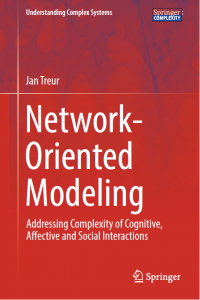
During a sabbatical period in 2015 I decided to start working on a book on the Network-Oriented Modeling approach developed over the past years and which has turned out useful in modelling complex integrated individual and social human processes in the form of networks. The decision to spend a considerable amount of time on such an enterprise led to further reflection on the modelling approach, and its presentation and positioning. This book presents in much detail this dynamic Network-Oriented Modelling approach. It enables to design complex high level conceptual representations of models in the form of temporal-causal networks, which can be automatically transformed into executable numerical model representations. Dedicated software is available to support designing models in a conceptual or graphical manner, and automatically transforming them into an executable format and performing simulation experiments.
The temporal-causal modelling approach incorporates a dynamic perspective on causal relations between states. States have real values that change over time due to the causal relations, but the causal relations have real value weights that can also change over time. Basic elements are networks of nodes (for the states) and connections (for the causal relations) with for each connection a connection weight for the strength of the impact of the connection, for each node a speed factor for the timing of the effect of the impact, and for each node the type of combination function used to aggregate multiple impacts on this node. The approach covers specific types of (recurrent) neural networks and social networks, but it is more generic; it also covers, for example, probabilistic and possibilistic approaches in which product or max- and min-based combination functions are used. By choosing suitable combination functions, every process that can be modelled as a smooth state-determined system by first-order differential equations, also can be modelled by the presented temporal-causal network format. Adaptive networks are covered by connection weights of the network that change over time, which, for example, can be used to model Hebbian learning in adaptive networks of mental states, or network change in social networks.
The temporal-causal network modelling format used makes it easy to take into account theories and findings about complex brain processes and social processes known from Cognitive, Affective and Social Neuroscience and Cognitive and Social Sciences, which, for example, often involve dynamics based on interrelating cycles, which themselves can also change over time. The approach enables to address, for example, complex phenomena such as the integration of emotions within all kinds of mental and social processes, of internal simulation and mirroring of mental processes of others, and of evolving social interactions. Many of such examples are illustrated in different chapters of the book.
Usually dynamic properties of dynamic models can be analysed by conducting simulation experiments. But sometimes properties can also be found or verified by calculations in a mathematical manner, without performing simulations. Mathematical techniques addressing this are also discussed. Such types of properties found in an analytic mathematical manner can be used for verification of the model by checking them for the values observed in simulation experiments. The properties analysed by the methods discussed cover stationary points and equilibria, increasing or decreasing trends, and recurring patterns: limit cycles.
The book forms the basis of a multidisciplinary course and has been written with such a multidisciplinary audience in mind without assuming much prior knowledge. In principle, the detailed explanations in the book allow it to be used as an introduction in Network-Oriented Modelling for multidisciplinary Master and Ph.D. students. In particular this implies that, although some more technical mathematical and formal logical aspects have also been addressed, they have been kept to the minimum, and are presented in a concise manner in a separate part that can be skipped if not needed.
Jan Treur, Network-Oriented Modeling: Addressing Complexity of Cognitive, Affective and Social Interactions. Springer Publishers, Series in Complex Systems, 2016, pp. 499. Download: https://link.springer.com/book/10.1007/978-3-319-45213-5
